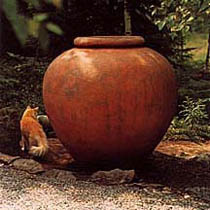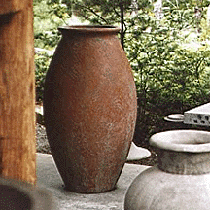In a 2002 Martha Stewart Show episode, America was introduced to the work of Dan Farrenkopf and Lunaform, the company he co-founded with Phid Lawless.
Based in the little town of Sullivan, Maine, just east of Bar Harbor, Lunaform is located on a cedar-lined dirt road that opens to the company’s display area of amazing garden planters and urns. A native Rockporter, Farrenkopf, a potter and 3D designer, hand spins his steel-reinforced concrete urns, each of which can weight over 2000 lbs and stand over five and half feet tall. The true art of his work is the rich blend of colors and textures that he brings to his pieces through his involved coloring process.



Here are 8 questions with Dan Farrenkopf:
Who or what influenced you in becoming a potter?
I’ve always enjoyed throwing clay pots, but I came around to this pursuit by combining passions. I love gardens and building objects. My studio’s focus came out of a collaborative investigation of architectural features for gardens. There are great gardening traditions on and around Cape Ann as well as where I live on the coast of Maine. This set the stage for me as I studied painting and architecture at a small liberal arts school in Maine and worked in gardens to pay for school. Specimen artifacts within these gardens inspired me to try my hand at it.
Who or what influenced you in becoming a potter?
I’ve always enjoyed throwing clay pots, but I came around to this pursuit by combining passions. I love gardens and building objects. My studio’s focus came out of a collaborative investigation of architectural features for gardens. There are great gardening traditions on and around Cape Ann as well as where I live on the coast of Maine. This set the stage for me as I studied painting and architecture at a small liberal arts school in Maine and worked in gardens to pay for school. Specimen artifacts within these gardens inspired me to try my hand at it.
What creatively inspires and motivates you with your work?
I am very inspired by gardens and the landscape within which I live. Creating architectural features for gardens in the form of concrete vessels of all sorts blends my love of gardens and sculpture. I really enjoy the partnerships with landscape architects and architects as well as with the crew Phil and I are lucky to work with.
I am very inspired by gardens and the landscape within which I live. Creating architectural features for gardens in the form of concrete vessels of all sorts blends my love of gardens and sculpture. I really enjoy the partnerships with landscape architects and architects as well as with the crew Phil and I are lucky to work with.
What are some of the influences for your current work?
I’m also inspired by contemporary clay, metal, and stone sculptors. Sequoia Miller of Washington creates clay vessels that are partially wheel-thrown and partially hand-built. The process yields exquisite pieces. Miller’s glazes complete hybrid vessels that are of both human geometries and naturally occurring. Curtis LaFollette of Maine is a silversmith working in many media, from furniture design to one-of-a-kind hollow ware mixed media vessels. The hollow ware gives license to pursue the idiosyncratic. LaFollette’s scale and material origin is fantastical, and brings to mind the containment of elements yet to be discovered. Jesse Salisbury of Maine is a stone sculptor using various Japanese splitting techniques to dissect large blocks of granite and basalt. Salisbury disassembles using wedges aligning to and at odd angles to the crystalline structure of igneous rock in complex, multi-step, stone surgeries. The rigging and headiness, and somewhat nerdiness, inspires me to push out of my studio’s comfort zone of actual weight or just scope.
I’m also inspired by contemporary clay, metal, and stone sculptors. Sequoia Miller of Washington creates clay vessels that are partially wheel-thrown and partially hand-built. The process yields exquisite pieces. Miller’s glazes complete hybrid vessels that are of both human geometries and naturally occurring. Curtis LaFollette of Maine is a silversmith working in many media, from furniture design to one-of-a-kind hollow ware mixed media vessels. The hollow ware gives license to pursue the idiosyncratic. LaFollette’s scale and material origin is fantastical, and brings to mind the containment of elements yet to be discovered. Jesse Salisbury of Maine is a stone sculptor using various Japanese splitting techniques to dissect large blocks of granite and basalt. Salisbury disassembles using wedges aligning to and at odd angles to the crystalline structure of igneous rock in complex, multi-step, stone surgeries. The rigging and headiness, and somewhat nerdiness, inspires me to push out of my studio’s comfort zone of actual weight or just scope.
What is your greatest fear?
I dread anyone ever getting hurt at the studio, but being mauled by a bear is right up there.
I dread anyone ever getting hurt at the studio, but being mauled by a bear is right up there.
Where do you feel pottery is going?
As people think about where their food is coming from, connecting community to their food source, ceramic arts have a role in connecting a community to place by exploring their local ceramic material. Now, pottery in general continues to, and this includes our studio, connect people to vessels, an ancient art form. Containing and dispensing has enormous practical, metaphorical, and ceremonial significance in art’s investigation of the human condition. We all use pen drives, cameras, and sigg bottles as our 21st Century pots.
As people think about where their food is coming from, connecting community to their food source, ceramic arts have a role in connecting a community to place by exploring their local ceramic material. Now, pottery in general continues to, and this includes our studio, connect people to vessels, an ancient art form. Containing and dispensing has enormous practical, metaphorical, and ceremonial significance in art’s investigation of the human condition. We all use pen drives, cameras, and sigg bottles as our 21st Century pots.
What music are you listening to?
Shark Quest off of David Byrne’s internet radio station. This play list changes monthly, and nearly half of the artists each month are new to me. I’m not too sentimental about old music; I like to hear new work. I’m also not much for narrative lyrics, you know, songs that tell a linear story. I prefer abstraction like “The King of Carrot Flowers” by Neutral Milk Hotel. New combinations in pop music appeal to me.
Shark Quest off of David Byrne’s internet radio station. This play list changes monthly, and nearly half of the artists each month are new to me. I’m not too sentimental about old music; I like to hear new work. I’m also not much for narrative lyrics, you know, songs that tell a linear story. I prefer abstraction like “The King of Carrot Flowers” by Neutral Milk Hotel. New combinations in pop music appeal to me.
What are you reading?
Cod by Mark Kurlansky is a book about the settlement of North America from a fishery perspective, and I’m always reading something about honey bees. This month, it’s more of The Hive and the Honey, revised addition edited by Joe M. Graham, a must-have for everyone who loves insects.
Cod by Mark Kurlansky is a book about the settlement of North America from a fishery perspective, and I’m always reading something about honey bees. This month, it’s more of The Hive and the Honey, revised addition edited by Joe M. Graham, a must-have for everyone who loves insects.
What roll does Rockport play in your work?
I’m sure everyone has one place where their dreams originate. For me, it is Rockport. Although I don’t visit often, my subconscious is always chugging along there. I live on the coast of Maine, which in many ways is a lot like Cape Ann. As in Rockport, everybody knows who you are, except in Hancock County, where I live, where the same number of people is spread out a bit more, like maybe an hour and a half radius by car. I’m a small business owner, a grant advisor at the Maine Community Foundation, and an arts event organizer with The Schoodic International Sculpture Symposium. A small town teaches you that this is kind of a responsibility, and a way to give back to your community.
I’m sure everyone has one place where their dreams originate. For me, it is Rockport. Although I don’t visit often, my subconscious is always chugging along there. I live on the coast of Maine, which in many ways is a lot like Cape Ann. As in Rockport, everybody knows who you are, except in Hancock County, where I live, where the same number of people is spread out a bit more, like maybe an hour and a half radius by car. I’m a small business owner, a grant advisor at the Maine Community Foundation, and an arts event organizer with The Schoodic International Sculpture Symposium. A small town teaches you that this is kind of a responsibility, and a way to give back to your community.
To learn more about LunaForm and the work of Dan Farrenkopf visit:
LunaForm
66 Cedar Lane, Sullivan, Maine 04664
Call: 207- 422 – 0923
Visit on the web at: http://lunaform.com
66 Cedar Lane, Sullivan, Maine 04664
Call: 207- 422 – 0923
Visit on the web at: http://lunaform.com
Other artist mentioned in this interview:
Sequoia Miller http://www.sequoiamillerpottery.com
Curtis LaFollette http://www.lafollettegroup.com
Jesse Salisbury http://www.jessesalisbury.com
